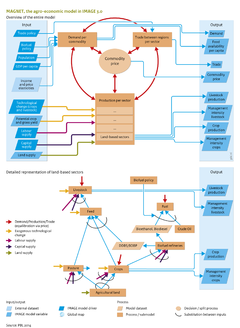Agricultural economy: Difference between revisions
Jump to navigation
Jump to search
ElkeStehfest (talk | contribs) No edit summary |
No edit summary |
||
| Line 7: | Line 7: | ||
|IMAGEComponent=Land use allocation-Agricultural systems; | |IMAGEComponent=Land use allocation-Agricultural systems; | ||
|ExternalModel=EFIGTM model; | |ExternalModel=EFIGTM model; | ||
|KeyReference=Woltjer, | |KeyReference=Woltjer, 2011; Stehfest et al., 2013; | ||
Stehfest | |||
|InputVar=Population per Region; GDP per capita; Capital and labor supply; Agricultural trade policies; Yield increase; Biofuel policies; Land supply; Potential crop and grass yield; Cropping intensity; Income and price elasticities of agricultural commodities demand; | |InputVar=Population per Region; GDP per capita; Capital and labor supply; Agricultural trade policies; Yield increase; Biofuel policies; Land supply; Potential crop and grass yield; Cropping intensity; Income and price elasticities of agricultural commodities demand; | ||
|OutputVar=Crop production; Management intensity crops; Management intensity livestock; Timber demand; Food availability per capita; Commodity price; Livestock production; | |OutputVar=Crop production; Management intensity crops; Management intensity livestock; Timber demand; Food availability per capita; Commodity price; Livestock production; | ||
Revision as of 13:47, 9 December 2013
Parts of Agricultural economy
| Component is implemented in: |
|
| Related IMAGE components |
| Projects/Applications |
| Key publications |
| References |
Key policy issues
- What is the area of cropland and grassland required to support future food demand?
- What are the policy options to reduce agricultural land use and to safeguard global biodiversity, while ensuring food security?
- How can the implications of biofuels for land use and greenhouse gases be managed sustainably?
